A deep, melodic whistle pierced the morning silence. It echoed off a dozen surfaces in the sloping valley, creating a harmony that lasted long after the original source had stopped. As the last notes faded away the assembled crowd, the few of us that there were, swiveled around and peered into the distance. We squinted our eyes against the bright sunlight, still tinged with orange from distant fires. A puff of dark smoke could be seen rising up, dissipating in the cool air but offering us a sure signal that our wait was almost over: the train was on its way.
I was brought to Virginia City on this crisp summer morning by the promise of the railroad. It was the third weekend that the Virginia & Truckee was carrying passengers over the 12 miles of reconstructed track between Carson City and the Comstock. The project had been in the works for decades; almost as soon as the rails were pulled up enterprising railfans were getting their heads together, devising ways to get them put back down. Only in the last ten years had the project actually come to concrete reality, and even then only through the sheer force of government subsidies. Use public money to put the tracks in place, and figure out the details later. Now the tracks were down, and the details were starting to come together. $48 per person for a round-trip ticket, a six-hour excursion into the heart of history, riding on the back of an iron horse just as they did a century and a half ago. Was it worth the cost? Was it worth traveling to western Nevada from San Francisco or Denver or Peoria, Illinois? Would it place Virginia City, and by extension Carson City, onto the summer travel itineraries of folks all over the country? That is what I was there to find out.
In Virginia City you hear the train before you see it. The clanging of the crossing bells, the squealing of the wheels, the hiss of the steam. Then slowly, around the corner comes the first coach; the train is being backed into the station, and the engine is facing the wrong way. It may look weird, and it doesn’t make for the best pictures, but it’s been this way on the Comstock for over 30 years. The engine was set down on the tracks with its boiler pointing north, and point north it has ever since.
Locomotive #29 was originally built in 1916 to pull logs. In northern Oregon trees were as good as gold, and they had what seemed like an endless supply. So engines like this were churned out by the hundreds from the Baldwin Locomotive Works in Pennsylvania. This one found its way to the Willamina & Grand Ronde Railway as #680, where it worked for probably 50 years before being stored away in an enginehouse. It was the age of diesel, and steam locomotives were seen as useless relics that cost too much to operate and couldn’t pull as many cars as the newest models coming off the line. Countless thousands of locomotives were melted down for scrap metal during this period, with only the lucky few surviving untouched. #680 was one of the lucky ones.
In 1977 Bob Gray was looking for more power for his one-year-old railroad in Virginia City. During the 1976 season he had rented a locomotive, but he soon saw the financial benefits of buying his own and went on a search for one he could get his hands on. A number of original V&T engines still existed, but they were all in the hands of film studios or museum groups, and most of them were out of service anyway. He needed something that could be steamed up with a minimum of costly repairs, and his search led him to Grand Ronde Oregon, where #680 was slumbering. He loaded it up on a flatbed truck, and spent the weekend hauling it to Virginia City.
32 years later, we stood on the platform blinking into the low morning sun as the same engine, now numbered #29, groaned to a halt. In front of it were two beautifully restored coaches, the Gold Hill and the Silver City. These two coaches came to the Comstock just last year, being bought by the Gray family special for excursions like this. They came from the Kettle Moraine Railway, a small tourist railroad in Wisconsin that had to close down in 2001. But before that the cars were part of the livery on the Erie&Lackawanna Railroad, carrying passengers between New Jersey and Chicago.
They are gorgeous cars, with soft wicker seats that reverse so you can sit forwards or backwards. The windows open and close so you can decide if you want fresh air or not, and they have authentic lamp fixtures and baggage racks up in the clerestory. And for being 85 years old themselves, the cars ride very smooth. Very little rocking or bumping as you glide down the track.
Once the train slid to a halt at Virginia city, and after we had gathered around the locomotive for pictures and to wish the engine crew well, we climbed on board. Since we were taking the morning “dead head” run down the hill, the train was not very full at all. Maybe only a quarter of what the cars could hold. But because of the way they have scheduled the trains, these dead head runs are necessary. The main excursion travels from Carson City to Virginia City at 10am every Saturday. Then it departs the Comstock at 3pm, bringing everyone back to where they started. This is the round-trip, and the one for which most of the tickets are sold at $48. But the train doesn’t spend the night in Carson City, so it has to make a run down the hill in the morning to be in position for the 10am departure, and it also has to go back up the hill at the end of the day. These are known as the “dead head” runs, because they’re not exactly part of the scheduled excursion, they’re only there to get the equipment into the right place. So they decided to sell tickets on these dead head runs for a reduced fare of $29, or give seats away free to media types such as myself. The downside is that this is a one-way trip; you end up stranded at the other end, and you better have a friend who can pick you up.
Knowing this, I had arranged for my wife to meet me in Carson City. And with two quick blasts of the whistle, the steam valves opened and the engine came to life, and we backed slowly out of the Virginia City depot.
If you’ve ridden the V&T in Virginia City before, then you’re familiar with the first 15 minutes of the journey. This modern-day operation follows the same winding path that the very first trains on the Comstock did 140 years ago. Bob Gray, when he rebuilt the line in the 1970s, made sure to follow the original right-of-way as closely as possible, snaking past ruined buildings and crumbling foundations that had been new when they first felt the steam of a passing train. Virginia City has been through more than a century of decay since the mines played out and everyone left town. The tourist boom of the last 40 years has brought people and money back to the Comstock, and restored many of the old buildings, or at least arrested their decay. But many of them were too far gone to save, so as the train rattles through town the conductor points out several old ruins that were once glorious buildings, or deep mine shafts.
One of the first excitements on the route is Tunnel #5, which actually isn’t much of a tunnel anymore. The roof was ripped off of it several decades ago to build a highway bridge, so now it is little more than a steep-walled rock canyon. After passing that you leave Virginia City and get a glimpse of the boundless expanses of Nevada desert. It’s hard to imagine how people survived in this unforgiving place before civilization, gruff miners building shacks out of the little wood they could find and having no more possessions than could fit on a burro. But the lure of gold and silver was strong, and once word got out about the big strike, people flooded this area. From the time the first shovel was put in the dirt to the time Virginia City was a bustling metropolis with its own railroad took less than 20 years.
Our train winds its way into the first real tunnel of the trip, and also one of the longest. Tunnel #4 pierces a ridge of stone and dirt in the area known as the “divide”, a hilly region separating Virginia City from Gold Hill. The tunnel was declared unsafe in the 1930s, and at the very end of V&T service to the Comstock passenger cars were not allowed to travel through it. Cars had to be spotted at Gold Hill, and the engines proceed on by themselves to get a sip of water at the enginehouse. But modern equipment came to the rescue in the late 1980s, and Bob Gray was able to reclaim the tunnel and make it safe for traffic once again. It’s now been 20 years that Tunnel #4 has been in use, and it’s just as stable as it was back in the glory days of the Big Bonanza.
The same can’t be said for Tunnel #3, located just a few hundred yards further. This tunnel was drilled through Homestead Point, a knoll overlooking Gold Hill that once held a military fort with a cannon. This tunnel was also declared unsafe in the 1930s, and Bob Gray had less luck reopening it. The east portal shows evidence of many collapses, just as wet sand will cave into a hole you dig at the beach. And once they did clear the way through, large boulders started falling from the ceiling. This was enough to make them forget about Tunnel #3, and instead they built a shoo-fly track around Homestead Point. It’s one of the few places the line deviates from the original right-of-way, and it’s also one of the tightest curves on the railroad. It does afford you an excellent view of Gold Hill that you wouldn’t get from inside the tunnel, though, so it makes for a more scenic trip.
Arrival in Gold Hill usually signals the end of the trip. From 1990 until 2007, this was the end of the line. Even today the normal daily excursions that the V&T runs will stop here, switch the engine to the front of the train, and then head back to Virginia City. But there was no stopping for our train, we were going all the way.

The Gold Hill Depot from the 1870s is still intact.
Just past the Gold Hill depot was another obstacle that the old railroad had to face, Crown Point Ravine. This steep canyon came out of the mountains and cut a v-shaped wedge right into the railroad’s path. In 1869 this challenge was met by building the Crown Point Trestle, a wonder of wooden construction that carried the trains more than a hundred feet above the bottom of the gorge. Folks doubted the safety of this structure, and the Central Pacific wouldn’t even let their cars cross over it until George Pullman himself had inspected it and declared it sound. The ravine was filled in the 1930s, though, and now instead of a dramatic high bridge there is only a wide expanse of yellow Comstock dirt. This is also the point where the train leaves the rails laid by Bob Gray and his family, and passes onto the new tracks constructed by the State of Nevada just a few years ago.
And while the Crown Point Ravine was filled in, another obstacle was created in the 1950s, this one manmade. Open pit mining was in vogue on the Comstock for a time in the mid 20th century, and just beyond Gold Hill was one of the openest pits of them all. The Overman Pit is hundreds of feet across and hundreds of feet deep, a gaping chasm in the ground dug right square on the route of the V&T. For years this was seen as one of the main obstacles to rebuilding the line, and it took a serious amount of money to get the job done. Nearly $4 million dollars was spent on filling in part of the pit, a narrow sliver of dirt that rapidly slopes away on both sides. The train perches right on top of this fill, scarcely enough room on either side of the train for anyone to stand. The train creeps along at an extra slow pace through this section, because any bad tie or loose rail could lead to a disastrous derailment.

Viewing the Gold Hill Cemetery from the heights of the Overman Pit crossing.
Past the Overman pit and back on solid ground, we come to American Flat. This wide valley never saw the mining activity that was seen in Virginia City and Gold Hill, but the residents were ambitious enough to try to snatch the state capital status away from Carson City. That bid failed when the mines proved to be duds and the residents left town. But American Flat still exists as a scenic part of the train ride, and the tracks skirt the valley in a broad semicircle that takes a full 20 minutes to navigate. Along the way are several sidings, including one at Scales, which historically was sort of a halfway house for trains heading up to the Comstock. There was a house and a water tank here, and overloaded engines could stop to rest and get a drink of water if the uphill climb proved to be too much for them. Today there is still a siding here, but no house, and water is provided by a tank car spotted on the siding. But it is still a stopping place where #29 can fill up on water during the long climb up to Virginia City if it needs to.

The water tank is not needed on the downhill trip.

Impressive ruins of a 20th-century cyanide mill in American Flat.
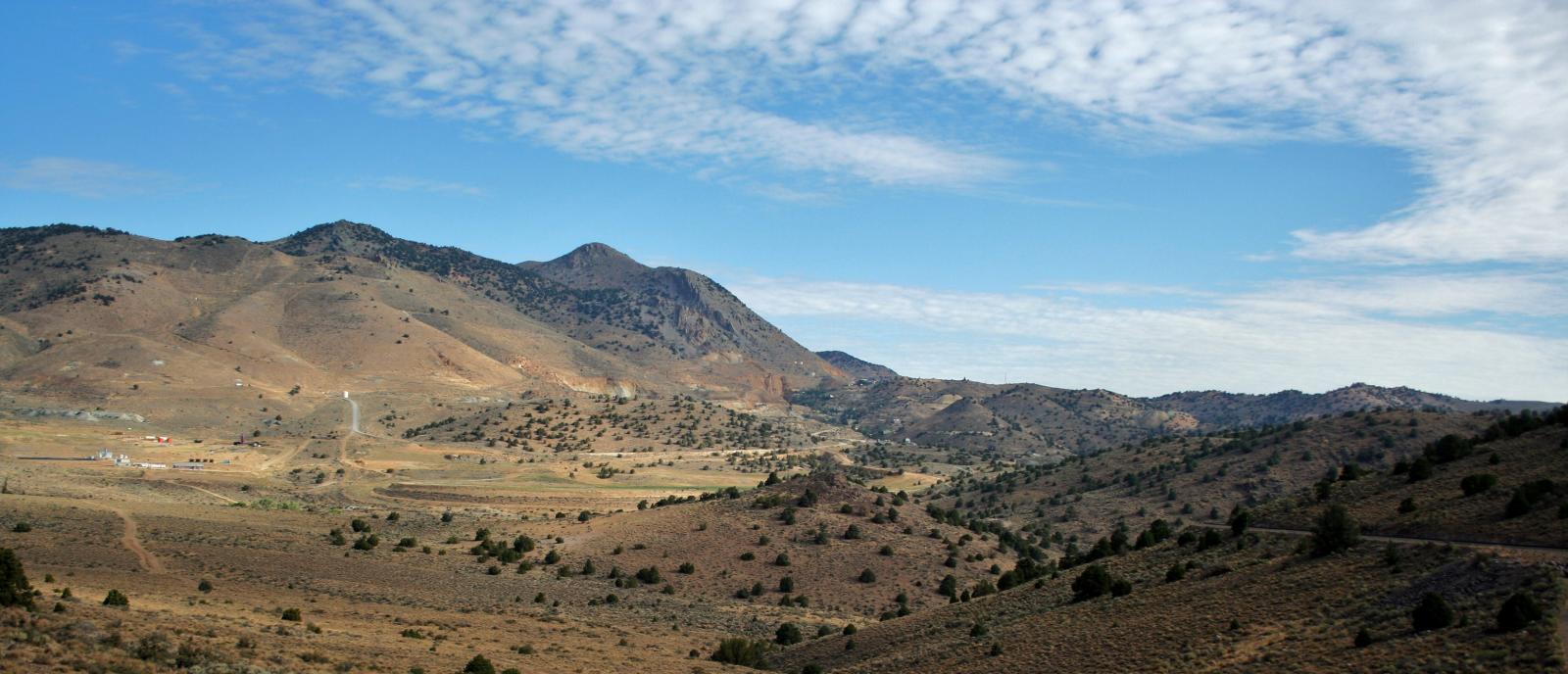
Looking back from where we came. Gold Hill, viewed to the north across American Flat.
For some, the nice lazy swing around American Flat may be the highlight of the trip. This is the one place during the voyage where you’re the most removed from civilization, probably the most likely to see wildlife, like deer or wild horses. The train keeps its slow pace, with the cars slowly rocking back and forth and the engine barely wheezing as it coasts downhill. These train cars really do offer a comfortable ride, for despite the fact that they are nearly a century old they glide along the track with hardly a bump or creak. And it helps that the new tracks you’re traveling on were built to a high standard; “overbuilt”, some have said. The railbed was graded perfectly smooth, high-quality ties were spaced out with precision, and heavy rail was used. And a professional rail contractor was brought in to do the job. Constrast this with the Gray’s potion of the line, which was built by hand with sweat and shovels, much of it by the Gray family itself. Critics say the new portion of the line was built to too high of a standard, and it’s way more than what is needed for a simple tourist line. The extra cost of doing it this way contributed to the price overruns that have pushed the project beyond the $50 million mark, and the price tag just keeps climbing.
After the 20-minute trip around American Flat, the train reaches Tunnel #2. Tunnel #2 was the longest of the seven tunnels on the original V&T line, and like Tunnel #3 it was cut through the shoulder of a mountain in order to avoid the tight curves that would have come from following the contour of the land. Tunnel #2 was the site of one of the first life-or-death situations on the V&T, as in October 1872 an engineer entered the tunnel with a full train behind him only to find the timbers in the tunnel on fire! The quick-thinking engineer squeezed all the speed he could out of the locomotive, and barely made it through to the other side. Startled passengers were stomping out embers that had blown into the cars, but all were safe. A temporary track had to be built around the outside shoulder of the hill until the fire damage could be repaired and the tunnel once again opened to rail traffic.
It was another fire, nearly a century later, that almost sealed the tunnel’s fate for good. In 1969, 30 years after the rails were pulled out of the tunnel, the wooden timbers once again caught fire. Some say it was hippie squatters that started the blaze. But after that the tunnel was deemed a public hazard by the county, and dynamited closed at both ends. One of the major engineering feats in the V&T Reconstruction was to reopen Tunnel #2 and see if it was salvageable. This work was done in late 2005, and luckily the crews found that the dynamite did little structural damage. Only the portals at each end had had to be rebuilt, this time with concrete, and new steel sets were put in to replace the old wooden supports. Tunnel #2 is now probably the safest tunnel on the line because of all the work that has been done to it.
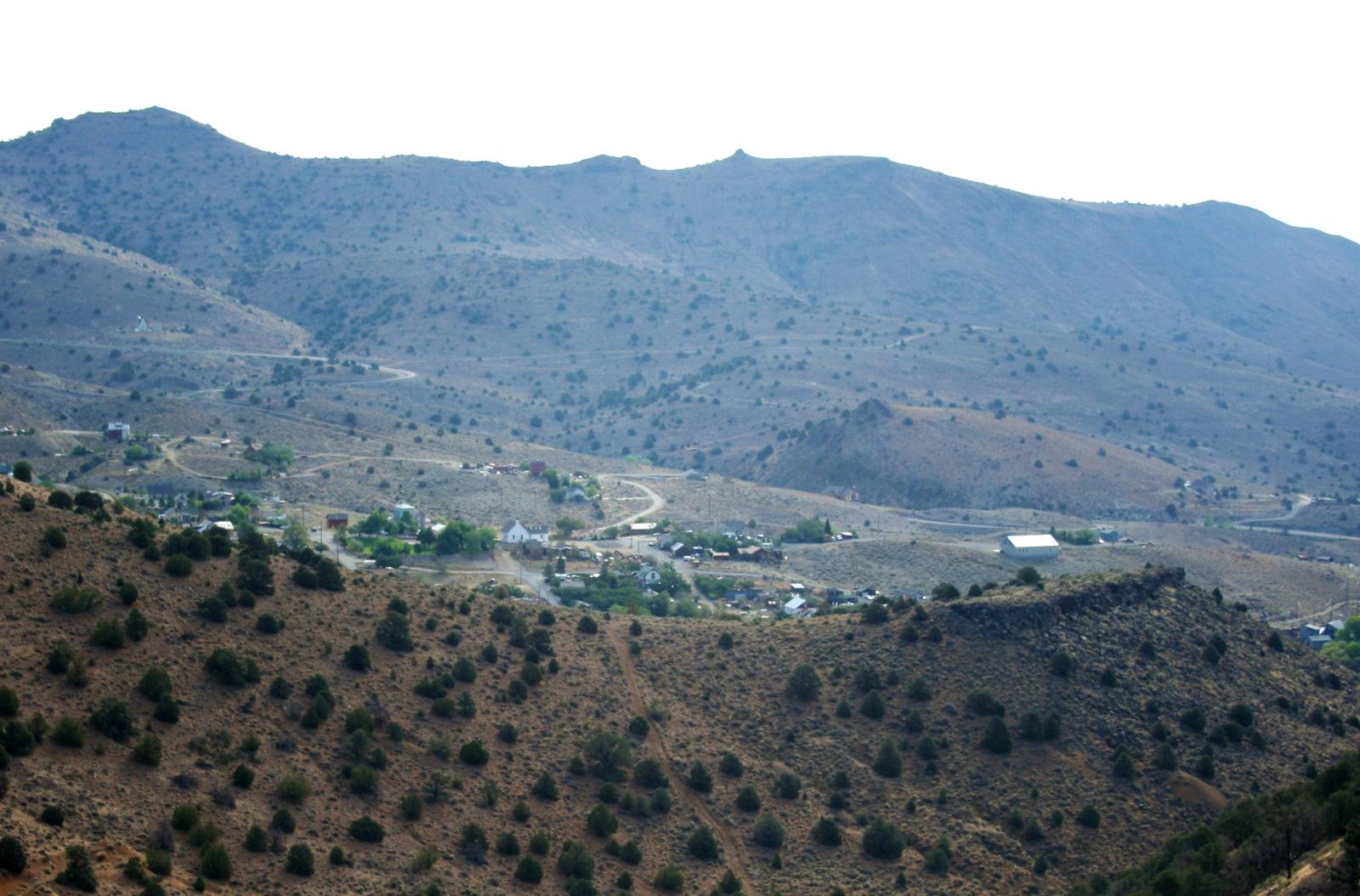
A fleeting glimpse of Silver City.
After another plunge into the darkness of Tunnel #2, the train emerges into a hilly canyon area unlike the American Flat that was just left. Parts of Silver City can be seen through a gap in the mountains to the east, and the Dayton Valley appears off in the far distance. But for a little while there is scant trace of civilization, and this is probably the most remote part of the whole trip.
Until, that is, you turn a corner and come into full view of Mound House. This is the point in the trip where the magic spell is broken; you can no longer pretend you’re a 19th century traveler taking the most opulent form of transportation available. Instead you look out the window and see the vast expanse of warehouses and gravel pits that is Mound House, and you’re instantly brought back to the 21st century. Mound House is the industrial complex of the Carson City area, and there is very little attractive about it. It used to be a stage stop, and later a railroad stop, for people travelling from Carson City to either Dayton or the Comstock. But in the last century low land prices have led to a huge industrial park being built in the town, as well as low income houses for everyone who can’t afford to live in Carson City. Not to mention the brothels. Prostitution is illegal in the most populous of Nevada counties, Carson City included. But right over the Lyon County border in Mound House sits the famous Moonlite Bunny Ranch, as well as a number of smaller, but by no means less notorious, places of ill repute. Much was made in the media earlier this year about the “train to the Bunny Ranch”, and while the track never passes closer than a half mile to the Moonlite, you can see its flashing red beacon from the train windows as you go through town.
After the excitement of Virginia City, Gold HIll, and American Flat, the Mound House voyage seems like the denouement to the trip. By this time you’ve been on board for nearly an hour. The scenery is decidedly less interesting, so you’re not as inclined to keep looking out the window. You know that you’re approaching your final destination, although there’s still another 15 minutes until you get there. And the grade is leveling out, not as steeply downhill, so even the engine has to start working again to keep your speed constant. Probably my least favorite part of the trip was when we skirted around Mound House.
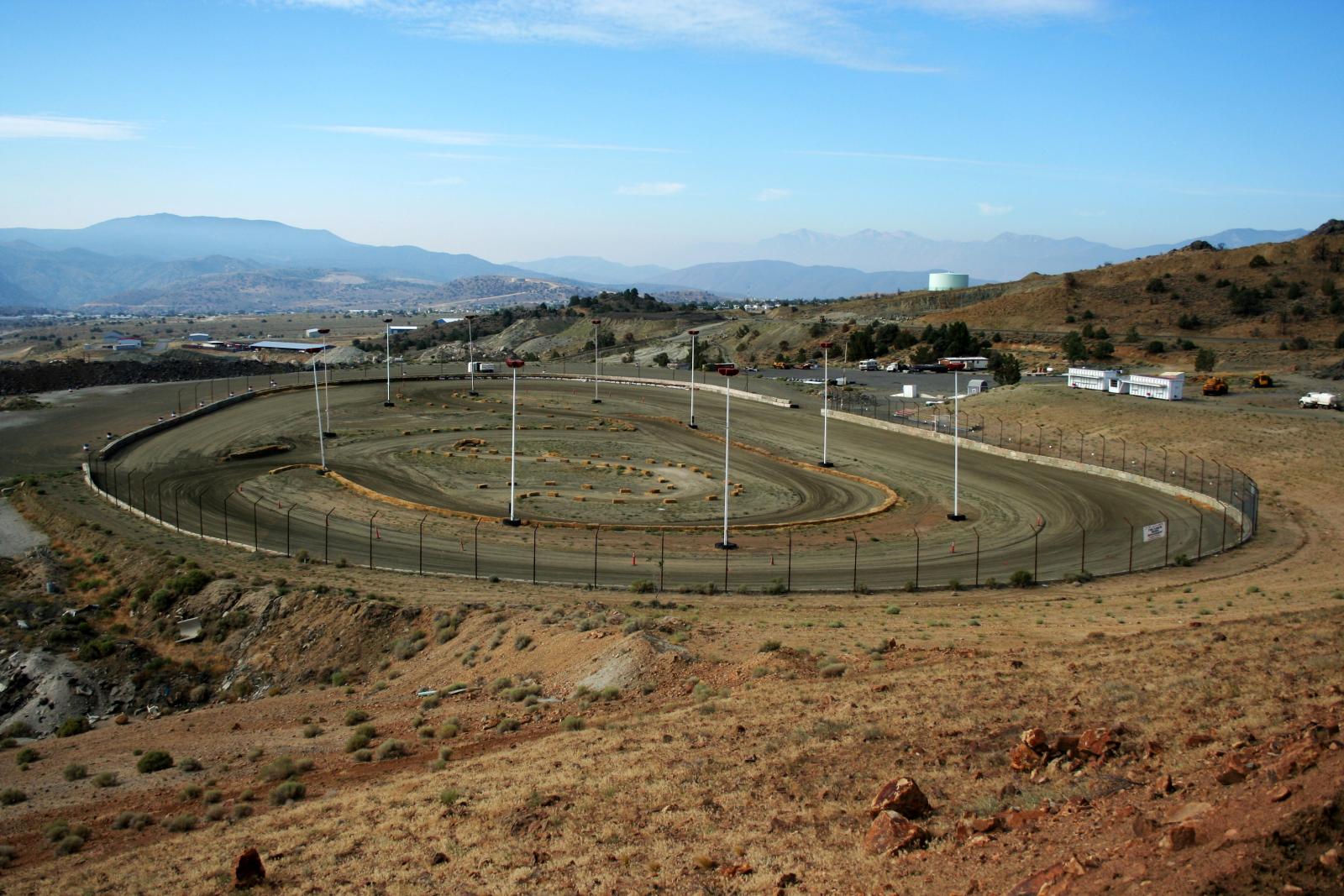
Dirt track racing in the hills.
At Red Rock Road, the reconstructed track veers off from the historic alignment of the V&T. The railroad at one time went right through the heart of Mound House, in fact only about a block away from where the Bunny Ranch now sits. But after the rails were pulled up in 1941, the railbed was graded and paved over, and is now a main thoroughfare through town. The town
is too built up to drive a railroad through it anymore. Plus the crossing at Hwy 50 was a grade crossing, which would be impractical now because of the amount of traffic on that road. So the decision was made to blaze a new trail, skirting around the western edge of Mound House and staying in the sagebrush on the end of town. One grade crossing was unavoidable, and at Linehan Road a full FRA-approved crossing with bells and gates had to be built. And the choice was made for the railroad to cross Hwy 50 at the very crest of the hill, where the topography made it possible for a bridge to span the highway. That way traffic wouldn’t be affected, except for the drivers who would be distracted by the sight of a steam locomotive crossing the bridge.
The bridge itself was a surplus piece of equipment donated to the project by the Union Pacific. It used to cross a freeway in Las Vegas, but when the freeway was widened the bridge became too short. It was the perfect length, though, to span Hwy 50. It was put into place in March 2009, and likely will stay there for decades to come.
As we crossed the bridge, the locomotive blew its whistle and the conductor encouraged us all to yell and wave at the traffic on the road below. Several of them waved back and honked their horns. Also at this point the locomotive finally started doing some real work, probably for the first time all trip, as the trip across the bridge and into Eastgate station is the one uphill part of the trip from Virginia to Carson. Black smoke wafted out of the funnel as we slowly inched across the bridge, and passed through some deep cuts in the hillside beyond that let the railroad avoid an auto junkyard in the area. Finally we hit the last straightaway, and the engine chuffed and wheezed as we approached the station. Many cameras on the hillsides and a large group of people were awaiting us, and with a final puff of steam and a long groan of the brakes, the train came to a stop at Eastgate Siding. Our journey was over.
Eastgate Siding is just the temporary end of the line for now. It is also part of the new alignment of the track, and until a couple of years ago it was just a windswept hillside populated only by rattlers and jackrabbits. But the V&T cut right through the hillside and built a large parking lot and platform here, so that excursionists coming from Carson City up to the Comstock would have a place to board the train. Construction has begun on extending the tracks beyond Eastgate, where they will rejoin the original alignment and descend into the Carson River Canyon. This part of the trip promises to be just as scenic as the trip through the Comstock, if not more so, as the train hugs the hillside high above the river, offering great views of the canyon below. Eventually the railroad grade comes down to meet the water, and a short trip along the river’s edge will bring the railroad to its ultimate final destination, on the far east slopes of the Eagle Valley. The date for completion of the whole project hasn’t been set yet, as it’s highly dependent on finding a source of funding to complete the work. But when it’s all done the total distance will be 17 miles from one end of the line to another, and Eastgate will be little more than a siding that is passed by quickly and silently.
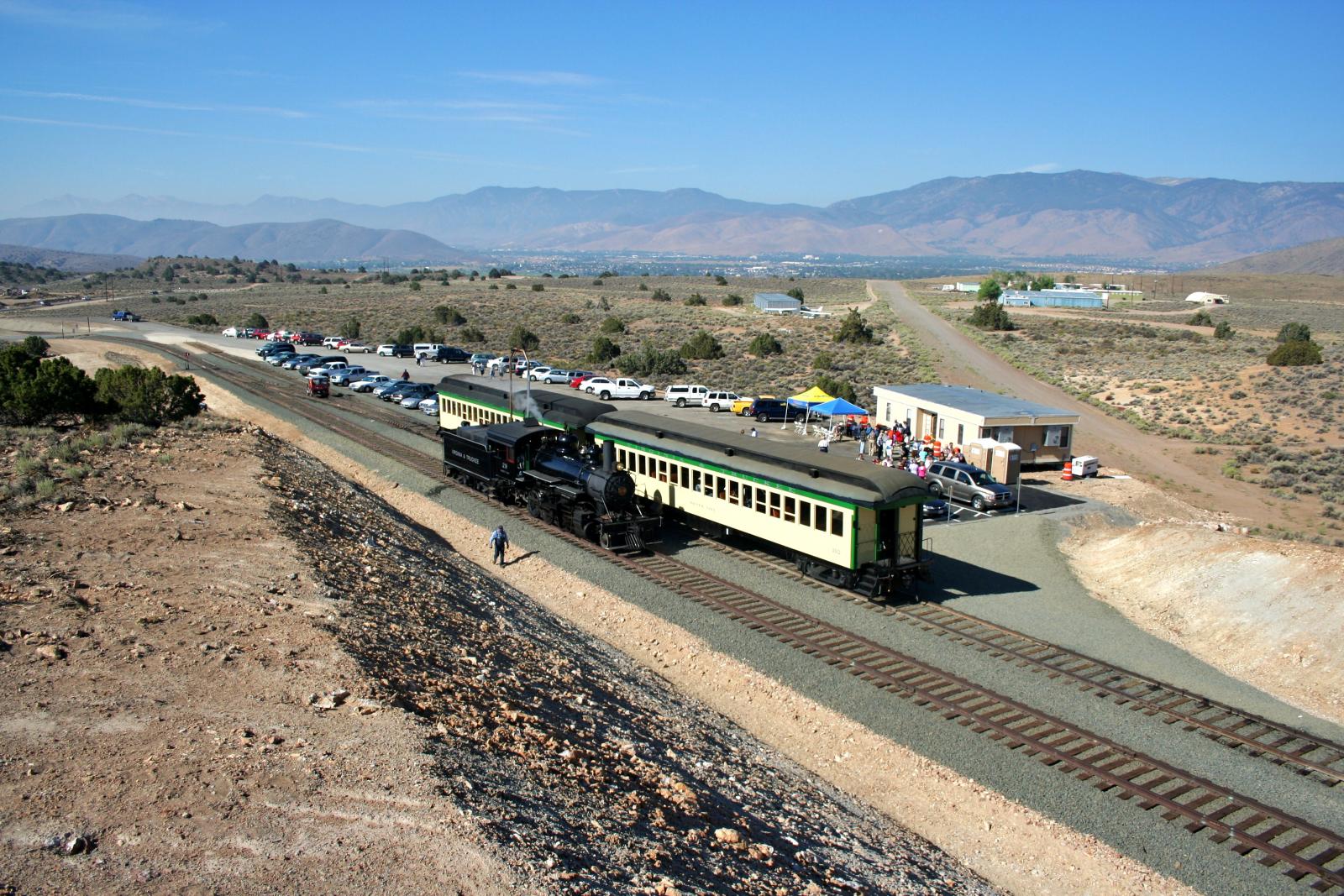
Moving the engine to the front.
But for now Eastgate is an important place. This is where the engine decouples and runs around to the uphill end of the train, finally being allowed to point forward for its journey back up the hill. It’s also where the locomotive stops to fill up on water for the long, arduous climb back to Virginia City. And it’s where we, the deadheaders, are kicked off the train to make room for the round-trip excursionists, those fortunate people who get to ride the train both ways. I can imagine the trip uphill is much more thrilling than the trip down. For one thing, the engine will be working the whole way, straining to pull its load back up the steep grades to Virginia City. For another thing, the Mound House segment of the trip is dispensed with early, saving the splendor of American Flat and the Comstock as a wonderful climax. And, the people with a round-trip ticket are given a few hours to wander around Virginia City, exploring the shops and taking in a bit of lunch, before reporting back to the station at 3:00 to make the trip back down the hill. The afternoon trip down would be similar to the one I just made, except with the added context of having already made the trip up just hours before. So when you pass by Mound House and pull into Eastgate Siding, the sun starting to set behind the Sierra, it really will seem like the conclusion of a full day.
Overall, this was a wonderful ride on the V&T. I’ve been waiting for this to happen since 1995, when I first started riding the train and the tracks came to an end at Gold Hill. Imagining them making it all the way down to Carson City seemed like such a far off dream back then, and I really doubted if it would ever happen. There are many people who need to be commended for making it come to reality.
And now the real test begins. A lot of money went into this project, some of it from private donors but much of it public funds invested in hopes of increasing tourism to the area. Now that the trains are actually running, we get to see how high interest is in a reconstructed V&T, and how many people from out of state will come here to ride it.
The prices for these inaugural runs are set rather steep, $48 for a round-trip adult ticket, and $29 for the one-way dead head that I rode. Child prices are slightly lower, but still a family of four is looking at laying down almost $200 for a trip on the train. In these economic times that can be a hard hit on a family’s wallet, especially when gas food and lodging prices are also at historic highs. But interest in the V&T has been high, with all of the first Saturday excursio
ns sold out. That could just be a rush to be one of the first to partake in a historic moment and ride the train during its inaugural season, though, and it’s doubtful if many of those people will come back for a second ride this fall, or even next year.
In evaluating whether or not the price of the V&T is “worth it”, people inevitably have been comparing it to similar railroads. One of the most common comparisons is with the Durango & Silverton, a steam excursion train in western Colorado. This train also takes you to a historic mining town, although through a much more green and lush landscape, along a dramatic river canyon. That ride has tiered pricing, depending on what type of coach you choose to ride in, but the basic ticket will run you $79. More than the V&T, but with a 90-mile round trip distance, and a more scenic route, it’s arguable that the D&S might be the better value.
Closer to home is the Sierra Railroad in Oakdale, CA, south of Sacramento. This railroad runs a variety of excursion trains, many of them dinner or lunch trains. Unlike the V&T and the D&S, there is no destination to speak of, and as I understand it the train just heads into the hills until it reaches a designated spot, then turns around and goes back. How far you go depends on which excursion you take, but the standard dinner and lunch seem to go about 32 miles round trip, still a little bit more than the V&T. And they include a meal served in the train’s dining car. And at $49 for lunch and $56 for dinner, it’s only scant dollars more than the V&T. You do miss out on the chance to disembark and spend time in Virginia City, though.
On the Northern California coast is the Skunk Train, a trip thorough the coastal redwoods with magnificent bridges and river canyons. According to the website, though, they only use a steam engine on “selected days”, otherwise you’re riding in a gas motorcar or behind a diesel locomotive. Their steam trip costs $47, just one buck less than the V&T, and lasts about 4 hours. But again, there is no destination; they just go up into the woods, then come back. For extra money you can stop for a bit and have a barbeque.
Also relatively close by is the Napa Valley Wine Train. This train is definitely a restaurant on wheels, and just like the D&S they offer tiered pricing depending on the level of elegance you go for. Lowest cost is $49.50 for the “Silverado” car, but the food is extra. You do get to travel though the scenic Napa Valley, on a 36-mile round trip. Again, the train just turns around without stopping at the destination. And no steam engines here, it seems to be all diesel.
So really, comparing the V&T to other excursion railroads isn’t an easy thing. So many of these trips have their own unique attributes that it makes a direct comparison impossible. In terms of price alone, the V&T is certainly equal to many of them, and less than the D&S. But when you compare the scenery offered on the other lines, many people would rather see lush green forests than dry sagebrush.
But at the same time the V&T has one thing none of the others have: Virginia City. This town has captured the public imagination for half a century now, and many people already come from all over the country to visit it. And the V&T that has been running for the past 33 years has never had any shortage of riders. In a lot of ways, actually, it’s that short trip the V&T currently offers, round trip to Gold Hill and back for $10, that is the biggest competition the reconstructed V&T has to go up against. How many people will decide it’s worth nearly five times as much money to go the rest of the way down, even if it’s more than five times the distance and duration? What they’re doing currently, running steam trains on the full excursion and diesel on the short trip, is another incentive to spend the extra money. But how many folks will decide to go for it? And will those riders really count, because they were already in the area for other reasons? The idea is for the V&T to be its own attraction, and for people to come from miles around because they want to ride the railroad. Then the money they spend in Virginia City, and in hotel rooms in Reno or Carson, the gas they buy, the restaurants they eat out at, all of that money pumped into the economy is money that wouldn’t be here if not for the railroad. It’s about helping to make Reno/Tahoe a destination, to go beyond skiing and gambling and look for more ways to get more people to come. And it might work; hopefully it’s an outrageous success and every trip is full from the boiler to the buffers. But I wouldn’t want to put my own money on that bet.
In the end, the trip down from Virginia City to Carson City was fantastically entertaining, and exciting because I had been waiting for it for so long. And my five-year-old son just loved it and still talks about it today. But I was offered a free pass because I write for this site, and they knew I would get the word out about the train. If I had to pay out of my own pocket, I don’t think I would have gone on the trip. And I think there are a lot of other people, both locally and out of state, who feel the same way and are turned off by the price. This $48 price is supposed to be a trial price for this year only, and they even claim it’s artificially inflated a bit because a portion of the revenue is going towards construction costs in the Carson River Canyon. What might the prices look like next year? Will they be lower? Will there be more runs than just the 12 we’ve had this year? I guess we’ll all have to wait to answer those questions.
If you’re interested in riding the V&T from Carson City to Virginia City, there are still 5 more excursions running this year. Every Saturday from now until Nevada Day, October 31st. The $48 round trip excursions seem to be sold out (good sign!), but the $29 deadheads are still available. You can choose the morning deadhead downhill, departing Virginia City at 8:00am, or the afternoon deadhead back up, departing Eastgate Siding at 4:30pm. Tickets can be had from www.visitcarsoncity.com, or at (775)687-7410.
All 75 of my photos of my ride are available at Flickr. Check back soon for a YouTube video of the trip.



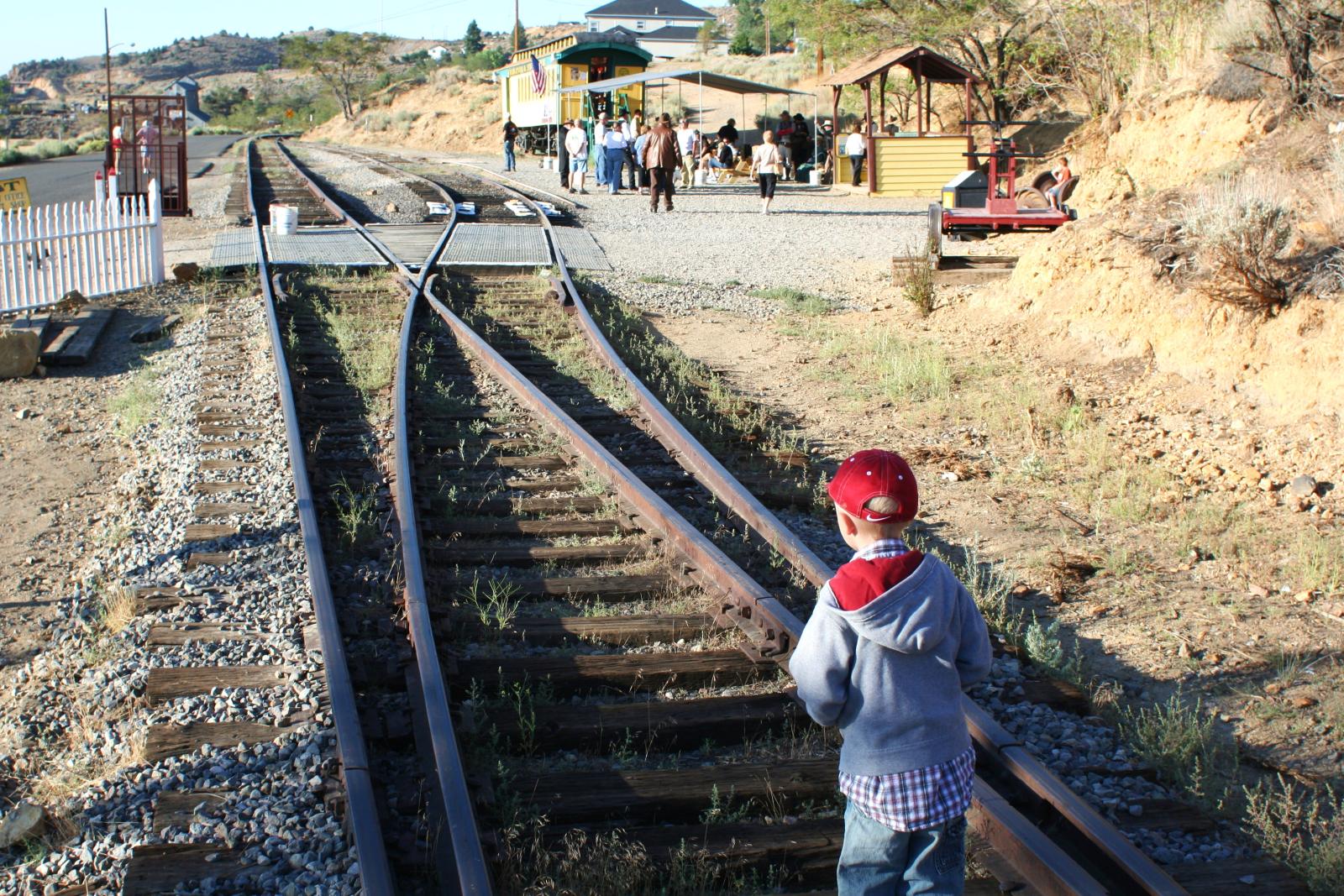
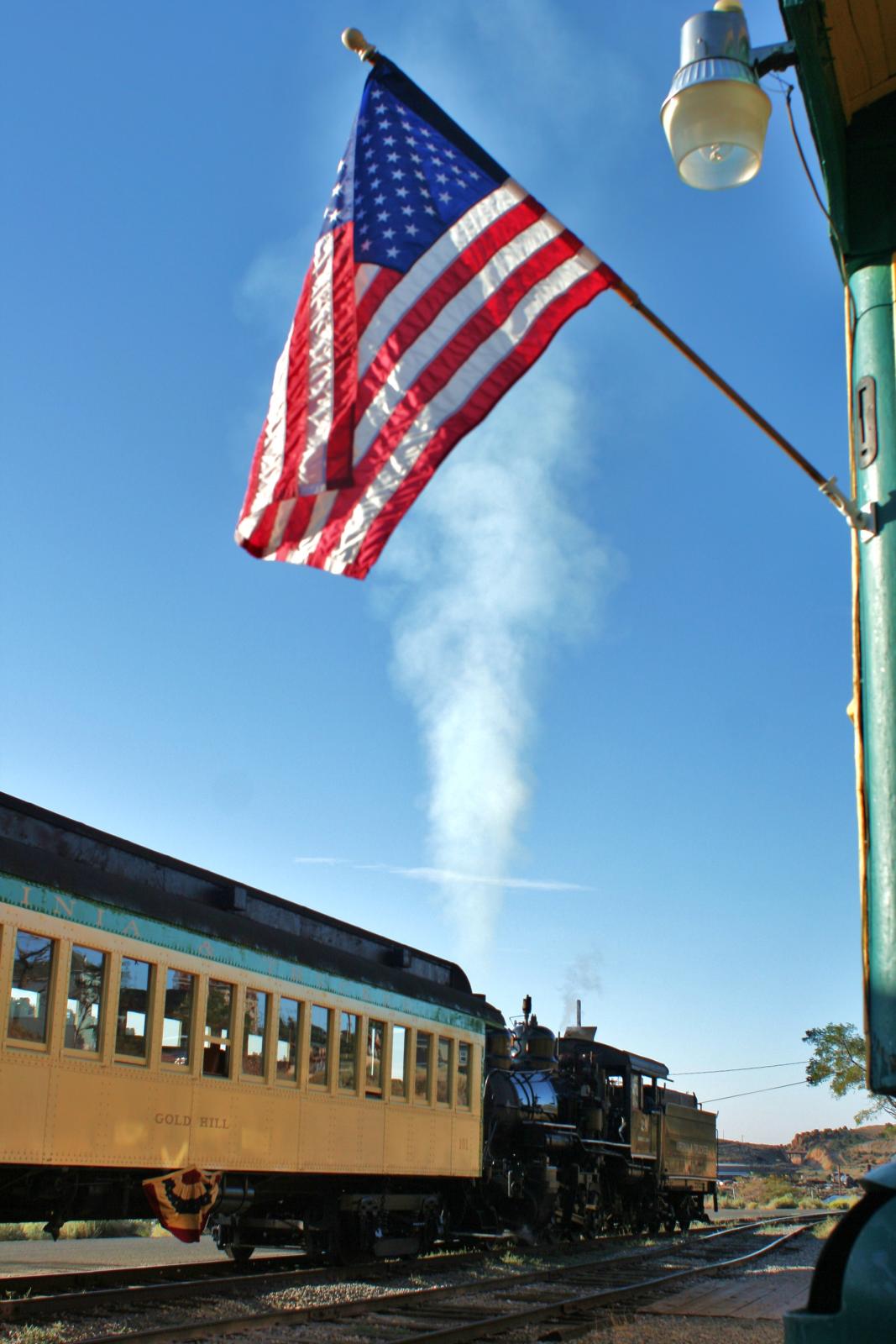

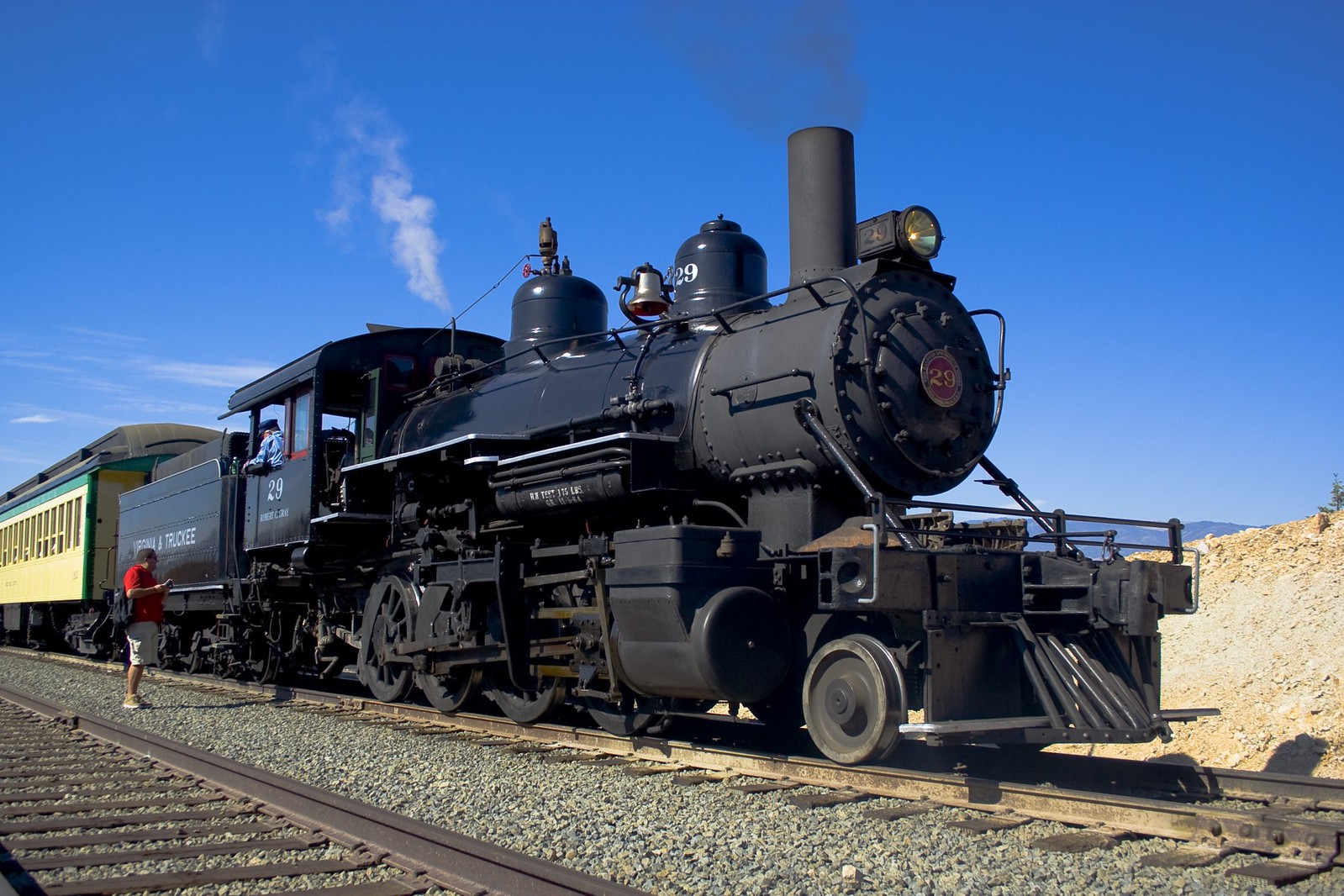





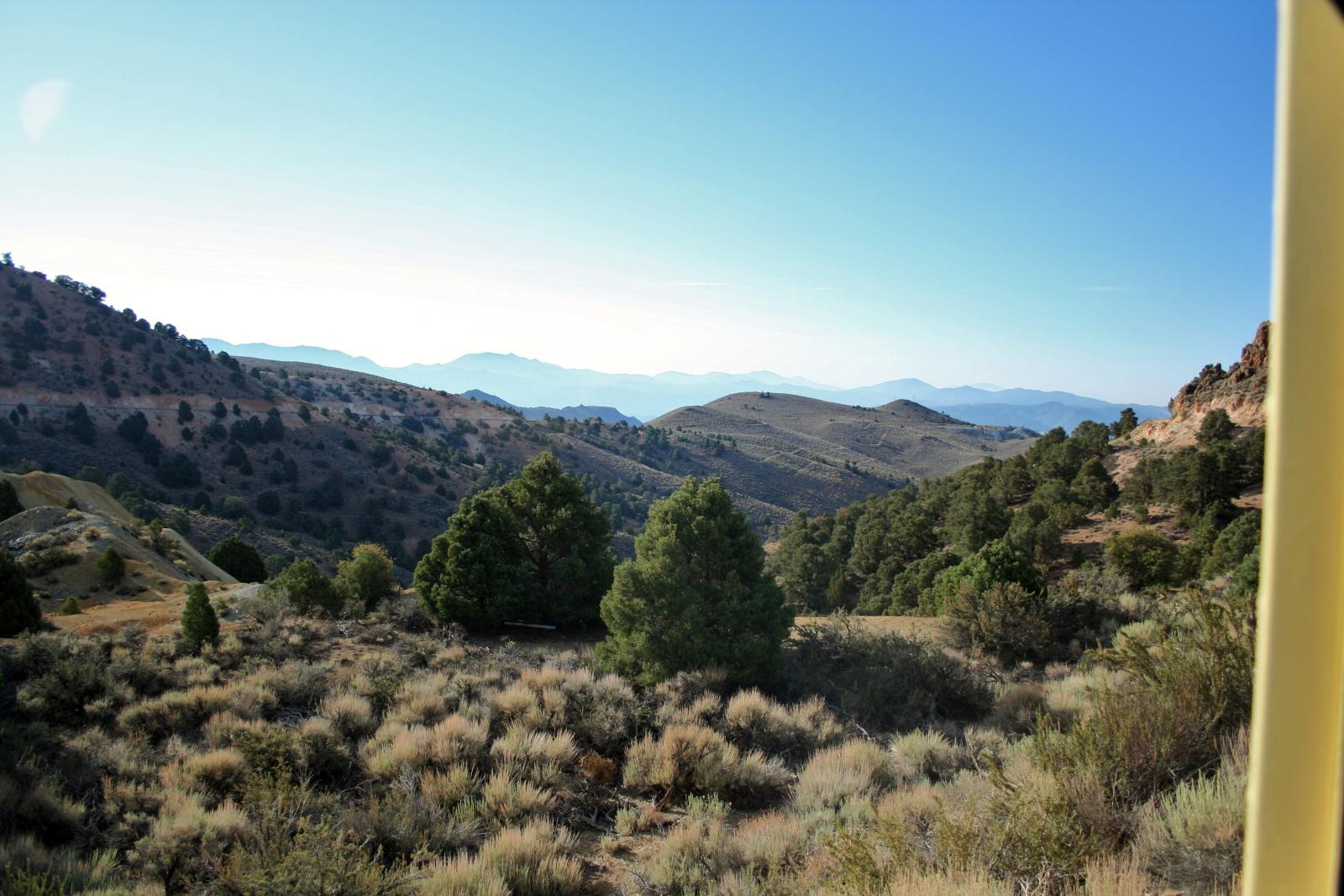




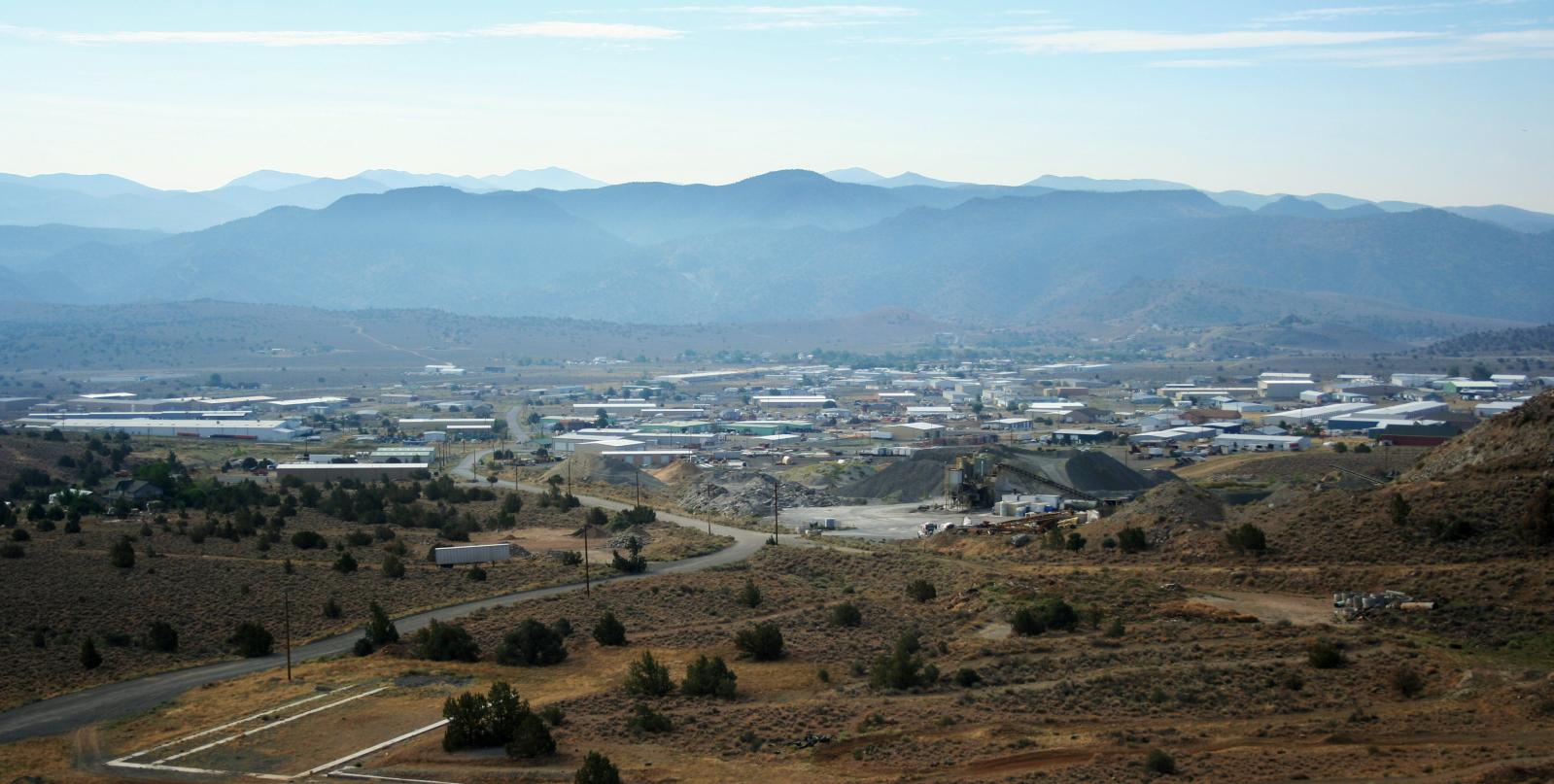





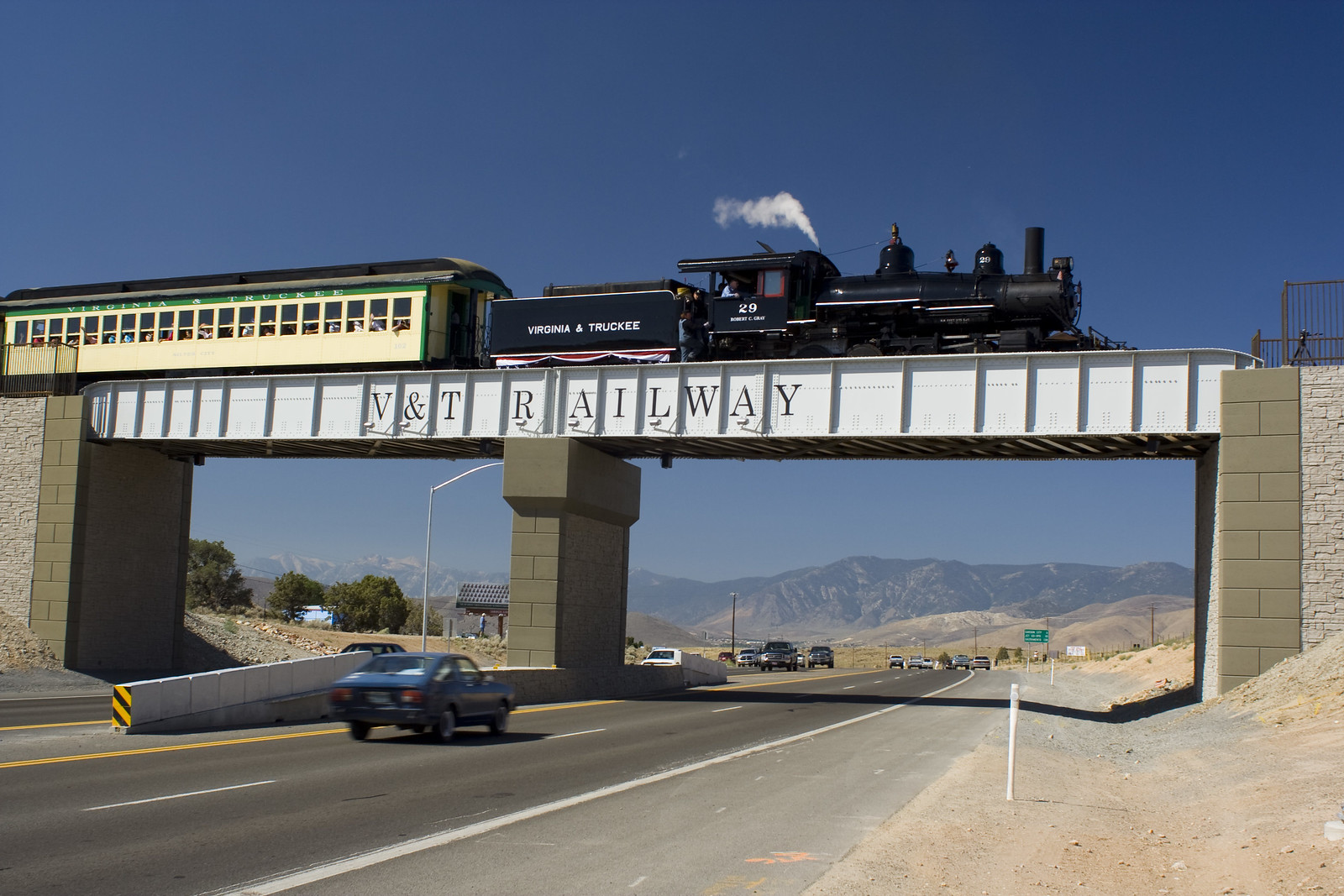
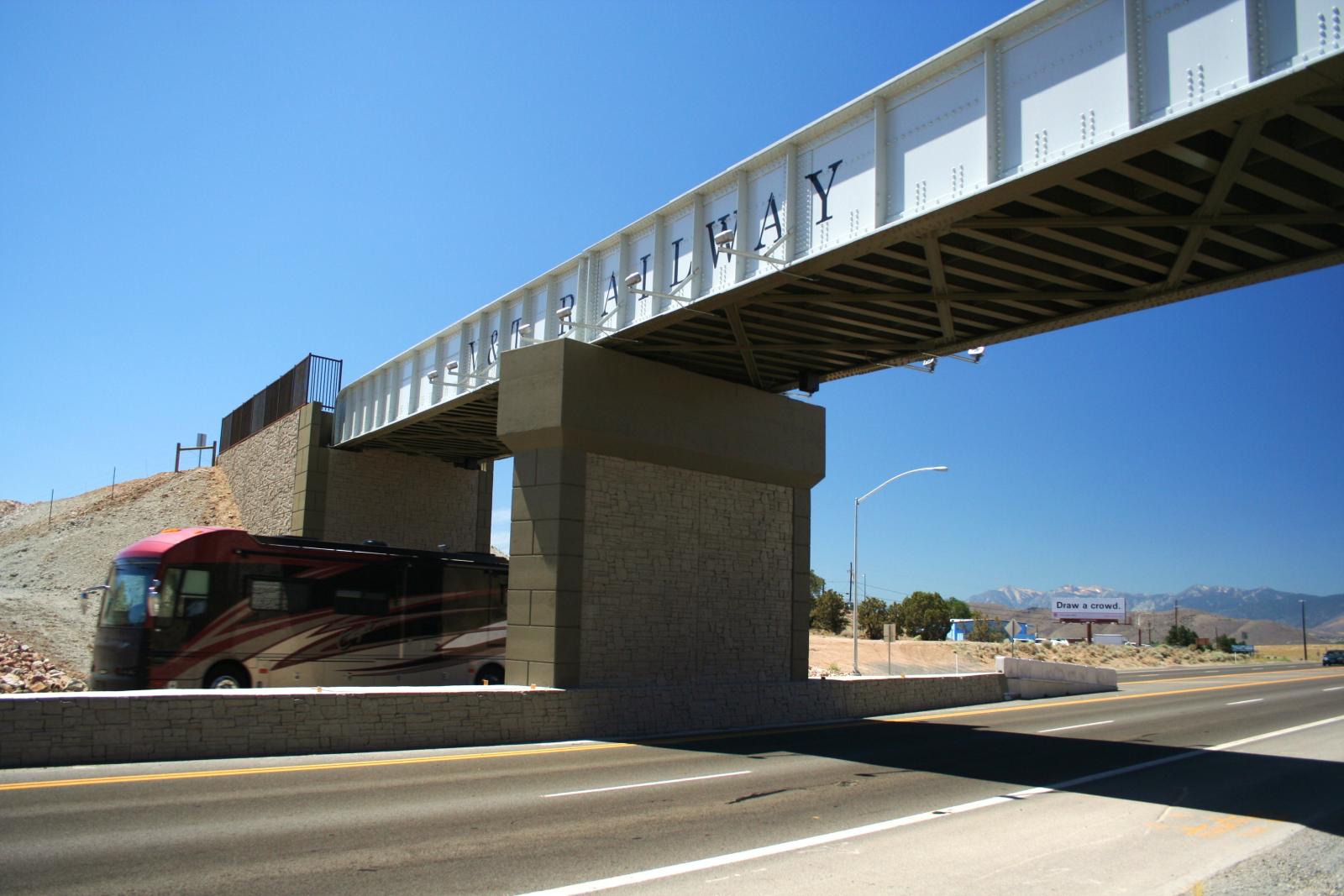
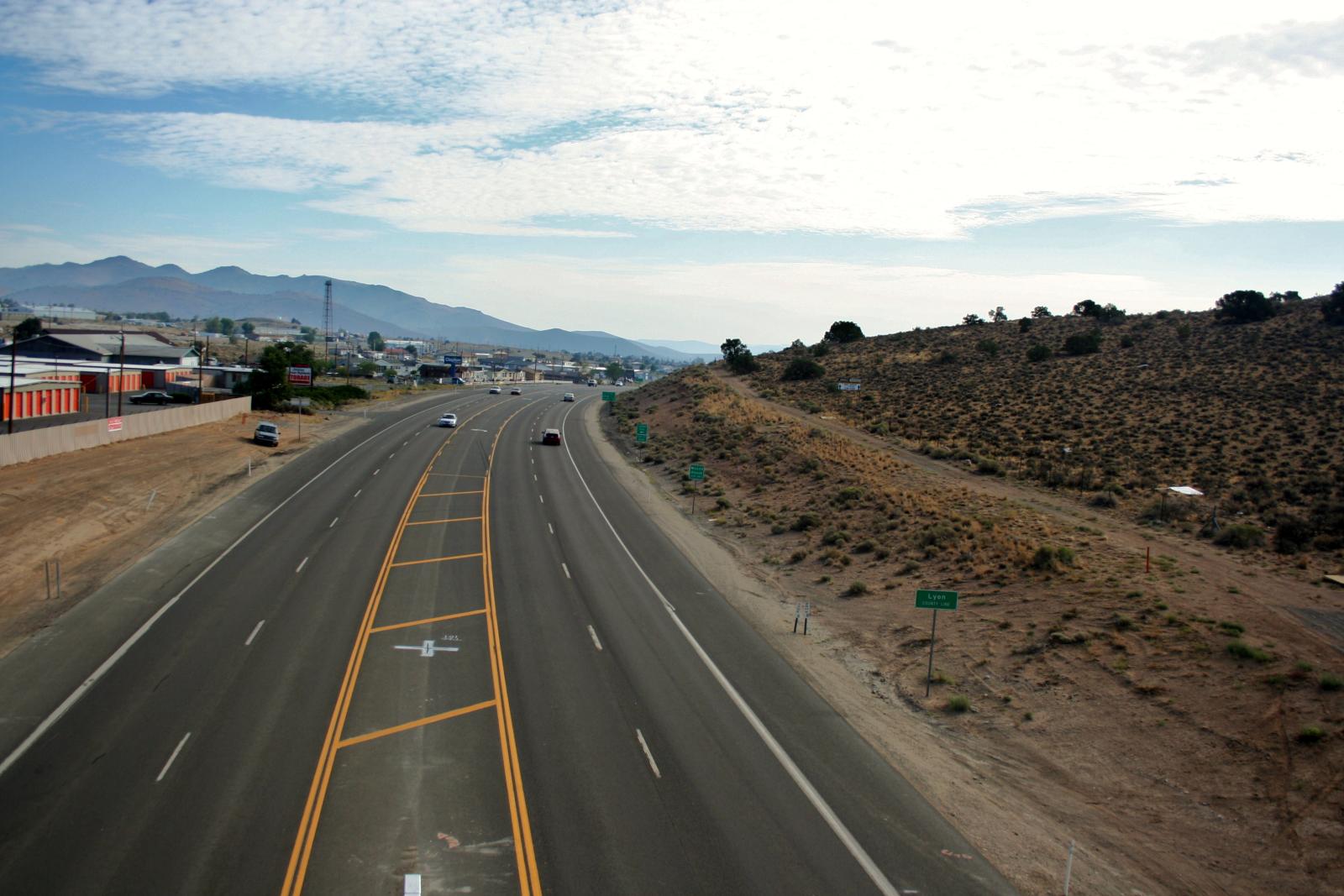



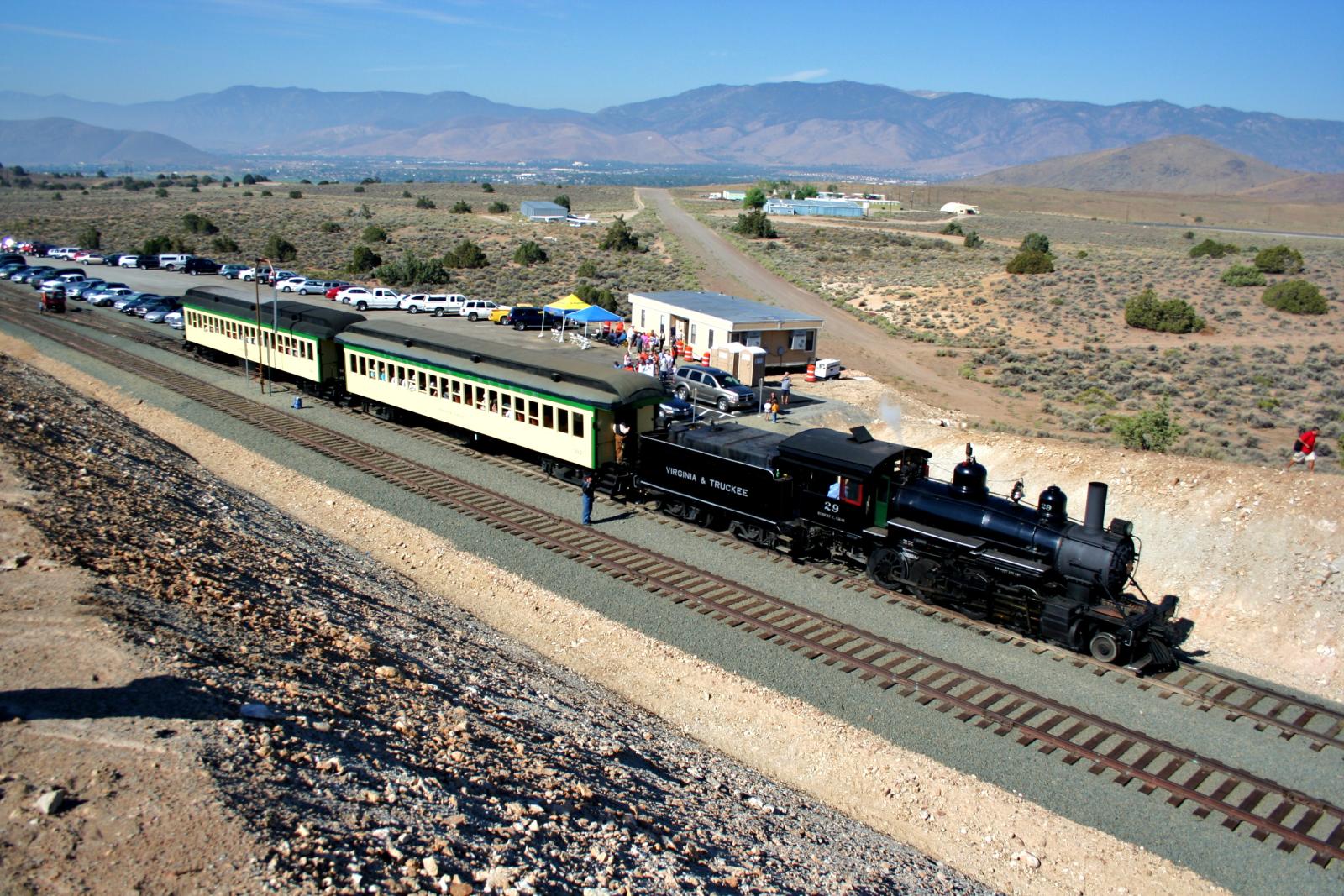


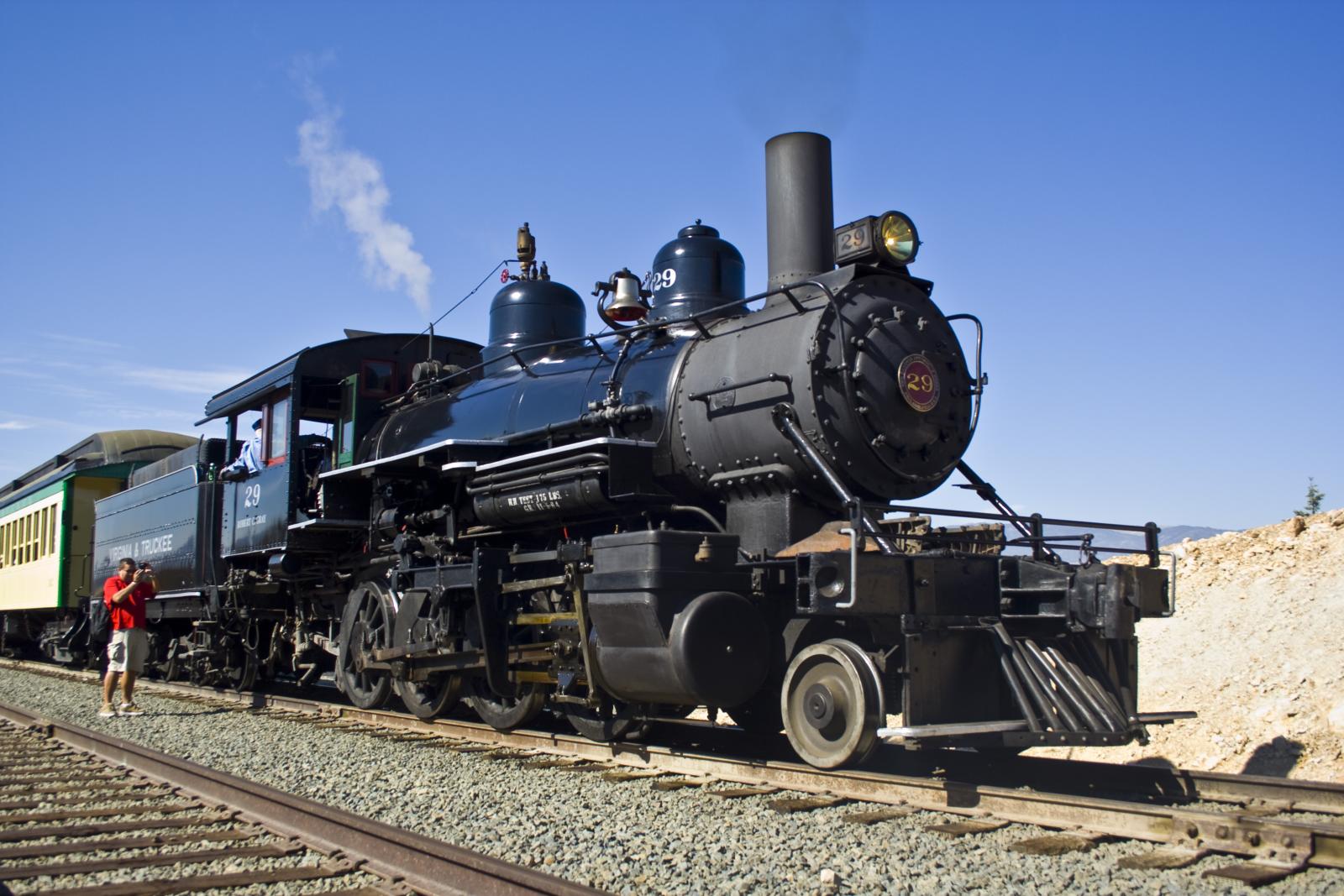
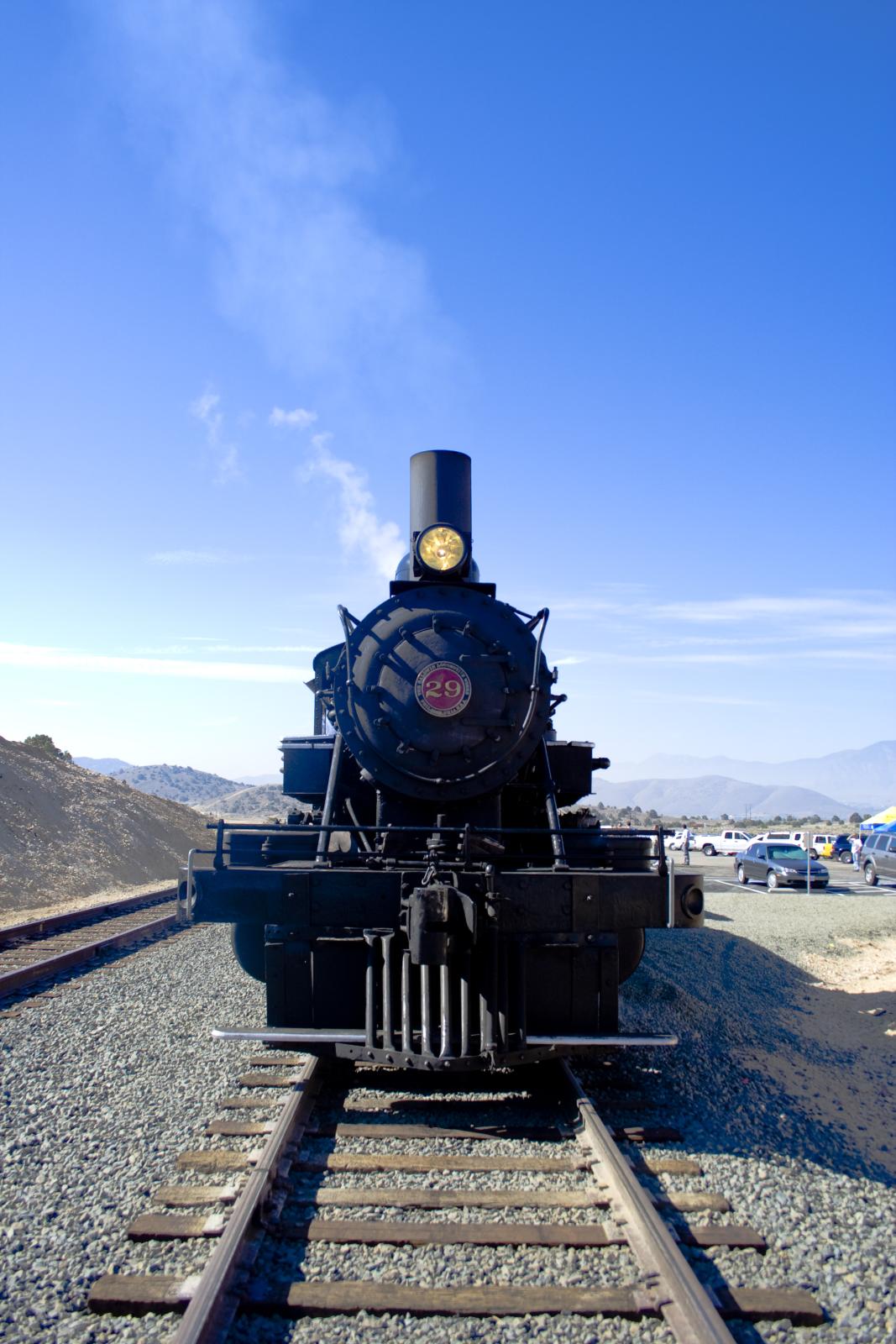





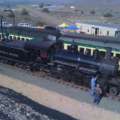
Great post! Thanks!
Thanks for posting this! Loved all the information and great images to go along with it!
Great writeup Scott! Putting aside the politics, this is a great trip.
Now for a tiny bit of politics. When they claim, “and they even claim it’s artificially inflated a bit because a portion of the revenue is going towards construction costs in the Carson River Canyon.” …
That’s hard to believe, since they are losing money on each run. When you figure the costs of paying the real V&T, the costs of constructing Eastgate Siding, the $35K marketing budget for this year, the cost of CCCVB selling tickets, and perhaps consider that the VIP party at $25K is being subsidized by these trips, they are losing about $2000 per trip. There is no profit to contribute to construction costs, in fact these trips don’t even contribute to maintenance costs.
But the powers that be in Carson have told us for years that the train will lose money.
Again, fantastic writeup and great photos! Thanks!
Wow! I have lived in Carson City for 5 years and never rode on a railroad train. Definitely will go after your article!
Thank you for posting it!
Scott … Outstanding! What a wonderful job you did covering this exciting experience. I’m looking forward to a ride and want to take my grandson. As a child I got to ride a short trip out in the east side of Carson-city for the state Centennial in 1964, I was 8 years old. They had temporary tracks set up and we just went a short way, my grandfather got tickets for my sisters and me. I’ll never forget!